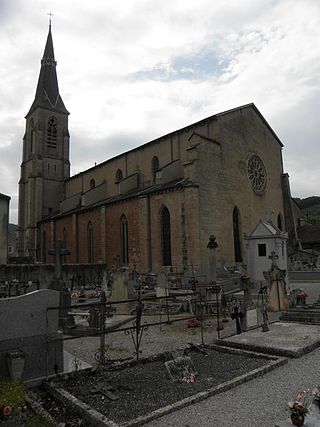
Glanate was a Gallo-Roman town on the right bank of the Var, which became the episcopal see of Glandève.

The Diocese of Périgueux and Sarlat is a Latin Church ecclesiastical territory or diocese of the Catholic Church in France. Its episcopal see is Périgueux, in the département of Dordogne, in the région of Aquitaine. The Diocese of Périgueux is a suffragan diocese in the ecclesiastical province of the metropolitan Archdiocese of Bordeaux. The current bishop is Philippe Mousset, who was appointed in 2014.

The Diocese of Chartres is a Latin Church ecclesiastical territory or diocese of the Catholic Church in France.

The diocese of Laon in the present-day département of Aisne, was a Catholic diocese for around 1300 years, up to the French Revolution. Its seat was in Laon, France, with the Laon Cathedral. From early in the 13th century, the bishop of Laon was a Pair de France, among the elite.

The former Catholic diocese of Mirepoix, in south-west France, was created in 1317 by Pope John XXII from the diocese of Pamiers. It existed until the French Revolution, and was suffragan of the Archbishop of Toulouse. Its see was Mirepoix, Ariège.

The former French Catholic Diocese of Noyon lay in the north-east of France, around Noyon. It was formed when Saint Medardus moved the seat of the bishopric at Vermandois to Noyon, in the sixth century. For four centuries it was united with the bishopric of Tournai as the Diocese of Noyon–Tournai. Then in the twelfth century it was again independent, and the bishop of Noyon became a pairie-comté of France.

The former French Roman Catholic diocese of Agde existed from about the 6th century to the Concordat of 1801 between First Consul Napoleon Bonaparte and Pope Pius VII. Agde is in the south of France, in what is now the department of Hérault. The last bishop, Charles François de Rouvroy de Saint Simon Sandricourt, was guillotined in Paris on July 25, 1794.

The former French Catholic diocese of Rieux existed from 1317 until the French Revolution. It was based at Rieux-Volvestre, south-west France, in the modern department of Haute-Garonne.

The former Breton and French diocese of Tréguier existed in Lower Brittany from about the sixth century, or later, to the French Revolution. Its see was at Tréguier, in the modern department of Côtes-d'Armor.

The former Breton and French Catholic Diocese of Saint-Malo existed from at least the 7th century until the French Revolution. Its seat was at Aleth up to some point in the 12th century, when it moved to Saint-Malo. Its territory extended over some of the modern departments of Ille-et-Vilaine, Côtes-d'Armor, and Morbihan. Until the 860s, it was often termed the bishopric of Poutrocoet.

The former French Catholic diocese of Saint-Omer existed from 1559 until the French Revolution. Its see at Saint-Omer, in the modern department of Pas-de-Calais, was created as a reaction to the destruction of the see of Thérouanne, by military action in the wars of the Emperor Charles V. It then became a suffragan of the Archdiocese of Cambrai in 1559.

The former French Catholic diocese of Senez existed from around the fifth or sixth century, until the French Revolution. Its see was at Senez, in southern France, in the modern department of Alpes-de-Haute-Provence. After the Concordat of 1801 the territory of the diocese was added to that of the diocese of Digne.

The former French Roman Catholic Diocese of Toulon existed until the Concordat of 1801. Its seat was in Toulon.

The former French Catholic diocese of Vence existed until the French Revolution. Its see was at Vence in Provence, in the modern department of Alpes Maritimes.

The Roman Catholic Diocese of Béziers was situated in France. It is no longer an independent diocese, and is part of the Diocese of Montpellier.

The Catholic Diocese of Castres, in Southern France, was created in 1317 from the diocese of Albi. It was suppressed at the time of the French Revolution, under the Concordat of 1801. Its territory returned to the archdiocese of Albi.

The Roman Catholic Diocese of Lescar, in south-western France, was founded in the fifth century, and continued until 1790. It was originally part of the Province of Novempopulania, and Lescar held the seventh place among the cities. Its see was the Cathedral of the Assumption in Lescar, begun in 1120; the crypt of the cathedral was also the mausoleum of the family of Albret in the 16th century.

The former French Catholic diocese of Vabres existed from 1317 to the French Revolution. After the Concordat of 1801 its territory was divided between the diocese of Cahors and the diocese of Montpellier.

The former French Catholic diocese of Boulogne existed from 1567 to the French Revolution. It was created after the diocese of Thérouanne was suppressed because of war damage to the see; effectively this was a renaming. The Concordat of 1801 suppressed the diocese of Boulogne, transferring its territory to the diocese of Arras. The seat was the Boulogne Cathedral, demolished in 1793.
The Italian Catholic diocese of Bertinoro existed from 1360 to 1986. In that year it was merged with the diocese of Forlì to create the diocese of Forlì-Bertinoro.



















